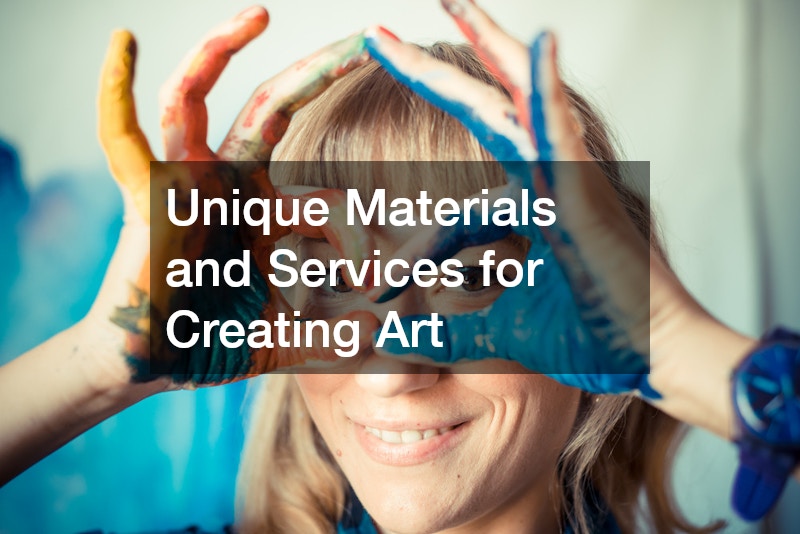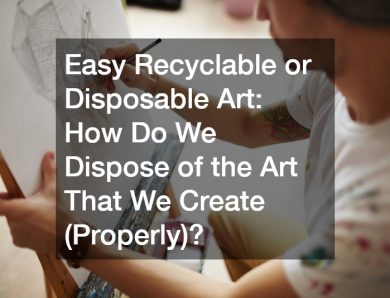
Unique Materials and Services for Creating Art

Art is often associated with canvas, paint, and brushes, but the world of creativity extends far beyond traditional boundaries. Innovative artists are continually on the lookout for unique materials that challenge the status quo, helping them break free from the mundane and explore the unconventional. In the quest for originality, many artists have turned their attention to various services and materials, such as lawn mowers, vending machine services, and the ingenious reuse of scrap materials, to create astonishing works of art that not only captivate the eye but also tell a story.
Utilizing unconventional resources not only fosters creativity but also promotes sustainability. By repurposing everyday items, artists can make stunning statements about environmental responsibility. Whether it’s through metal fabrication, pallet recycling services, or the imaginative spirit of local landscapers, there is an abundance of unique materials available to those daring enough to explore them.
This article will delve into various unique materials and the services that can facilitate their transformation into art. From snow plow blade manufacturing to cardboard box making machines, these unexpected sources hold the potential for artistic inspiration that resonates. Join us as we explore how these unconventional materials can be woven into the very fabric of modern art.
Lawn Mowing Parts
The humble lawn mower is often dismissed as merely a tool for landscaping, but its unique design and metallic components can lead to striking artistic creations. Many artists have successfully utilized lawn mower parts–such as blades and engines–as a foundation for sculptures and mixed-media projects. By creatively reimagining these components, artists bring new life to seemingly mundane items, turning them into pieces that challenge viewers to rethink their relationship with everyday tools.
Incorporating lawn mower materials into art not only showcases ingenuity but also prompts discussions about functionality and aesthetics. For instance, a sculpture made from a lawn mower blade could symbolize the delicate balance between nature and technology. As these pieces find their place in galleries or public spaces, they challenge audiences to engage in conversations about both sustainable practices and the allure of industrial design, highlighting the beauty in “unique materials.”
Furthermore, as artists seek out lawn mower components, they participate in a growing movement towards recycling and reusing materials in their creative processes. By rethinking the purpose of these tools, artists may inspire others to view lawn mowers in a new light, appreciating their potential for unique artistic expression. This shift opens up a plethora of possibilities for using unique materials that might otherwise contribute to waste.
Snow Plow Materials

Another fascinating source of unique materials comes from snow plow blade manufacturing. These large, durable blades are designed to endure harsh weather conditions, making them an excellent medium for artistic exploration. Many artists have discovered that repurposing blades, often adorned with the marks of wear and tear, adds a rugged aesthetic to their projects, creating visually captivating contrasts against softer elements like fabric or foliage.
Using unique materials from snow plow blades also allows artists to convey themes of resilience and adaptability. A piece crafted from these industrial elements could evoke the harshness of winter while simultaneously representing the beauty and struggle of surviving in extreme conditions. By weaving narratives into their work, artists not only create stunning visuals but also invite viewers to reflect on deeper environmental and social issues.
Beyond just the artistic value, the reduction of waste in the manufacturing process is another compelling reason to explore snow plow blade recycling. Collaborating with manufacturers and scrap metal recycling companies opens avenues for innovative partnerships that allow artists to gain access to unique materials. As creators engage with these services, they foster an artistic dialogue that emphasizes the importance of sustainable production methods while transforming industrial remnants into art.
Cardboard Boxes
In an age where consumerism reigns, cardboard packaging is ubiquitous; however, its potential as a unique material for art often remains overlooked. Cardboard box making machines provide a reliable source of raw material for artists interested in exploring the textural and structural properties of cardboard. By recycling these boxes into creative, one-of-a-kind sculptures or installations, artists challenge prevalent notions of luxury and scarcity.
Working with cardboard creates an interesting dichotomy between strength and fragility, enabling artists to express contrasting themes within their work. Thirteen layers of cardboard might serve as a strong foundation for a towering installation, while delicate, single-layer designs can evoke tenderness and impermanence. These unique materials invite exploration of form and texture, allowing artists to push the boundaries of traditional artistic practices.
Moreover, collaborating with cardboard box making machines promotes sustainability by reducing waste associated with packaging. Artists can tap into local suppliers and work with manufacturers to divert waste from landfills and into their creative processes. In doing so, they not only elevate the aesthetic value of cardboard but also shed light on the larger conversation about sustainable sourcing and responsible consumption.
Vending Machines
The vending machine service has evolved beyond merely dispensing snacks and drinks; it now stands as a unique canvas for creative expression. Artists have found innovative ways to repurpose old vending machines, transforming them into stunning art installations filled with non-traditional materials. By utilizing these unique materials, artists spark conversations about consumer culture and the transient nature of modern life.
For instance, incorporating a vending machine into an installation allows artists to play with functionality and accessibility. Imagine a vending machine that dispenses art instead of snacks–each purchase representing a moment of spontaneity and delight. This artistic interpretation invites viewers to ponder their own relationship with consumption and the items they value, reframing everyday experiences into something extraordinary.
Ultimately, vending machine services present opportunities for collaboration and experimentation with unique materials. By working with local businesses willing to donate or recycle discarded machines, artists contribute to a culture of sustainability while inviting engaging participation. The resulting artwork challenges the status quo and encourages deeper thinking about the role of art in everyday spaces.
Hardscaping Materials

Hardscape contractors play a valuable role in landscaping but are also an often overlooked resource for unique materials. With their expertise in stone, concrete, and other durable materials, hardscape contractors can provide artists with access to versatile components for their creative projects. By sourcing unique materials from these professionals, artists can elaborate on themes of permanence and nature, marrying their work with the environment.
For example, using stones and bricks can add a tactile, earthy quality to sculptures or installations. Artists might explore the juxtaposition of hard materials with softer, more ephemeral mediums, creating a visual dialogue that emphasizes balance and contrast. The collaboration between artists and hardscape contractors can lead to innovative urban installations that reflect the essence of the community and celebrate an intersection of art and nature.
Moreover, collaborating with these contractors informs artists about sustainable practices within the landscaping industry. By encouraging responsible sourcing and the reuse of natural materials, artists can contribute to environmentally friendly practices while supporting their local communities. Art becomes not just a visual experience but an embodiment of thoughtful stewardship and care for shared resources.
Landscaping Materials
Local landscapers are synonymous with unique materials, offering a wealth of organic and natural resources that can inspire artistic creation. Artists can collaborate with these professionals to explore the use of unconventional items like branches, stones, and foliage for their projects. The dynamic processes involved in gardening can lead to the cultivation of innovative works that highlight the relationship between nature and artistic expression.
By involving local landscapers, artists tap into expertise that helps them create site-specific art that blends seamlessly with its surroundings. For instance, landscape sculptures made from local plants may change with the seasons, engaging viewers with the ephemeral nature of art. The combination of unique materials and landscape design creates a living art piece that evolves over time.
Moreover, local landscapers can serve as advocates for sustainability and biodiversity, emphasizing the importance of native plants and ecological practices. By collaborating with these professionals, artists can communicate pressing environmental issues through their work, connecting viewers to the land and the environment. This synergy magnifies the conversation about ecological stewardship and the role of art as a catalyst for change.
Metal

Metal fabrication constitutes another fascinating area where unique materials come to life. Artists can collaborate with metal fabricators to create custom pieces, utilizing various types of metals–from aluminum to stainless steel. These materials offer durability and distinct visual appeal, enabling artists to craft striking sculptures that withstand the test of time while showcasing intricate designs and craftsmanship.
Working with metal affords artists a wide spectrum of possibilities in terms of texture, form, and color. For example, polished metals can produce reflective surfaces that play with light, while oxidized metals may present a visual narrative of age and history. By incorporating metal into sculptural design, artists convey messages of strength, fragility, and transformation, each piece an exploration of its own unique materials.
Collaboration with metal fabrication companies also encourages the exploration of sustainable practices. Many fabricators emphasize recycling and the use of reclaimed materials in their projects, aligning with artists’ environmental perspectives. In this collaborative effort, both parties can further promote the conversation about how art can intersect with industry while highlighting the significance of unique and sustainable materials.
Metal Stamping
Sheet metal stamping is a unique and versatile process that can significantly contribute to artists’ creative methodologies. The precision involved in stamping allows for intricate patterns and designs to be replicated, making it an appealing choice for artists interested in exploring repetition and detail. By utilizing stamped sheets, artists unveil unique materials that can echo themes of industrialization and craftsmanship in their work.
The unique properties of stamped sheet metal open exciting avenues for both sculptural and two-dimensional art. Artists can experiment with layering and assembling stamped pieces to create depth and dimension in their work. Furthermore, these stamped sheets can be painted, treated, or manipulated to evoke a myriad of emotional responses and conceptual ideas.
Incorporating sheet metal stamping also encourages artists to embrace collaboration with engineers and fabricators, thereby expanding their artistic toolbox. Access to the latest technology and techniques allows for innovative outcomes that can elevate their work. As artists merge creativity with manufacturing, they contribute to a broader dialogue about the role of unique materials and the fusion of art and industry.
Scrap Metal
Scrap metal recycling companies serve as treasure troves for artists seeking unique materials. By sourcing abandoned or discarded metal items, artists can transform scrap into stunning installations and sculptures that resonate with themes of waste, consumption, and renewal. The creative reuse of these materials not only makes powerful artistic statements but also promotes a sustainable mindset within the artistic community.
Using materials from scrap metal recycling companies fosters a sense of connection between artists and their environments. Each piece created from recycled metal carries with it a history and a story, inviting viewers to reflect on the lives of those materials before they were relinquished. In this way, artists elevate the mundane into the extraordinary, encouraging a renewed appreciation for industrial waste as a unique material.
Moreover, partnerships with scrap metal recycling businesses facilitate a sustainable approach to art-making by encouraging the responsible sourcing of materials. As artists advocate for reduced waste through their work, they inspire others to consider the implications of consumption and resource use. The footprint of scrap metal artistry reaches far beyond creativity; it serves as a crucial reminder of the importance of responsible stewardship and reshaping perspectives on waste.
Recycled Pallets

Pallet recycling services provide yet another remarkable resource for artists working with unique materials. Wooden pallets, often discarded after transport, can be repurposed into a variety of artistic endeavors, from furniture to intricate sculptures. The versatility and character of pallets make them a favorite among artists looking to introduce raw, organic elements into their work.
The process of transforming pallets into art extends discussions surrounding sustainability and resourcefulness. Artists can use pallets to create functional pieces that serve dual purposes, merging art with practicality. By emphasizing the unique features of reclaimed wood, artists highlight the beauty of imperfections and the stories embedded in each piece.
Additionally, collaboration with pallet recycling services enhances an artist’s ability to create works that resonate with the local community. By utilizing locally sourced materials, artists strengthen ties to their environment and foster community pride through art. The resulting pieces not only celebrate sustainable practices but also elevate the narratives of the people and places from which they originate.
Exploring Unique Services and Materials
Exploring the world of unique materials opens up an array of artistic possibilities that not only challenge traditional norms but also significantly impact environmental consciousness. From lawn mowers to vending machines, many unconventional sources inspire artists to harness their creativity while fostering sustainability. By emphasizing collaboration with professionals in various industries–such as hardscape contractors, local landscapers, and scrap metal recycling companies–artists can explore innovative techniques and materials that elevate their work.
As we have seen, each of these unique materials possesses characteristics that allow for creative exploration while promoting an environmentally friendly ethos. Artists who embrace these unconventional resources amplify their work’s meaning and significance, encouraging viewers to engage with art on a deeper level. In this ongoing dialogue between art, industry, and nature, the synergy of creativity transforms the mundane into extraordinary expressions of our world.
Ultimately, the journey of utilizing unique materials not only fosters artistic innovation but also serves as a reminder of our collective responsibility for the environment. By championing sustainability through art, we inspire future generations to appreciate the stories behind their materials and to seek beauty within the everyday. The art world’s evolution lies in its ability to adapt, innovate, and resonate through the art created from unique materials.




No Comment